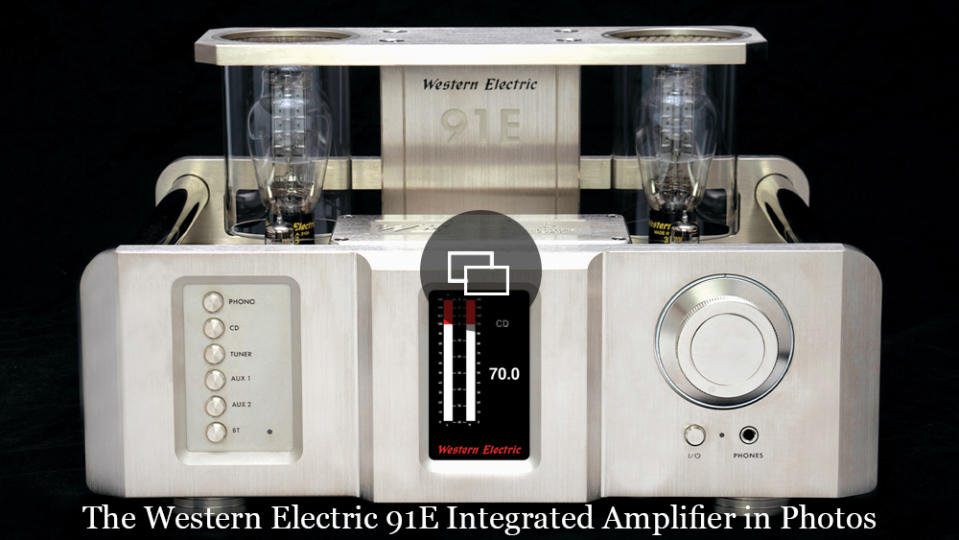Western Electric’s 91E Integrated Amplifier Is One of the Best Audio Components of the Year. Here’s Why.

The Western Electric 91E Integrated Amplifier, a category winner in the Robb Report 2023 Audio Awards, has made quite a stir since its recent introduction, and for a host of reasons. Just a single attribute would garner accolades, but the fact is, the 91E delivers on many notable counts. This Swiss Army knife of an integrated amplifier produces remarkable sound in a design that combines Bluetooth streaming with a sophisticated phono stage. It implements unique circuit topology using Western Electric’s 300B, the most venerated vacuum tube in audio history. It’s packaged in a flawlessly machined and finished single chassis that doubles as audio art. It would have been enough had the 91E Integrated Amplifier accomplished any of these objectives, let alone all of them.
Unquestionably our favorite two-channel product of the year, this vacuum-tube titan of amplification is a sight to behold. Squint one’s eyes, and it could be a scale model of monumental Greek architecture, a triumphal arch from ancient Rome, or a World’s Fair pavilion from our modern era. Two glass colonnades, one on either side of the chassis, each ensconce a single Western Electric 300B vacuum tube, which is the heart and soul of this amplifier, and its raison d’être.
More from Robb Report
Luxman's Sleek New Turntable Is Our Favorite of 2023 (So Far)
Naim's Pint-Sized Integrated Amp Delivers a Sonic Punch That's Well Above Its Weight
Sonus Faber's Newest Stradivari Loudspeaker Is an Instant Classic
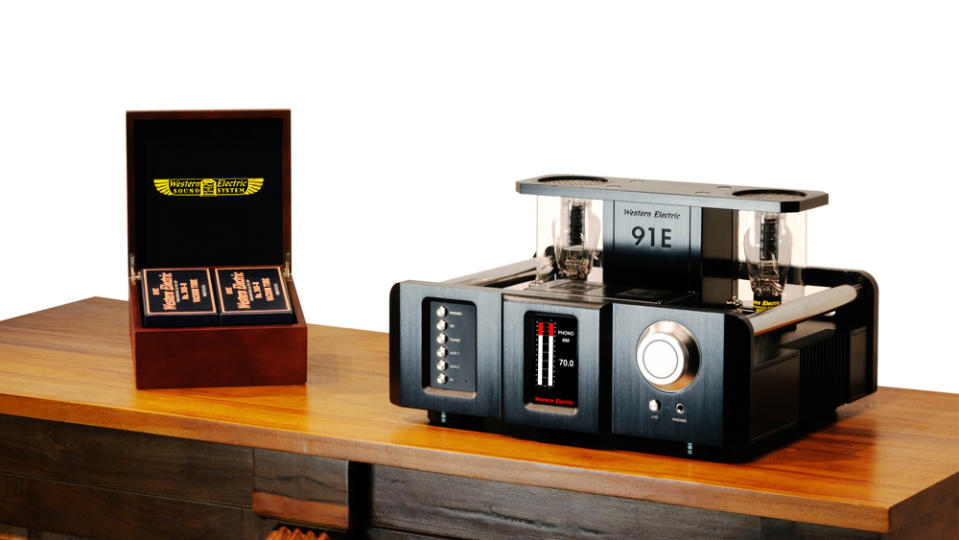
Opening the large wood-sided crate shipped from the factory in Rossville, Ga., one unpacks the main unit and a box containing accessories, various tools, gloves, and a user manual. A separate cardboard box contains a precious wood case whose lid opens to reveal a matched pair of Western Electric 300B vacuum tubes, each with its own serial number. These are available separately at $1,499 per pair, for use by owners of other 300B-based amps who want the best tubes money can buy.
The sound of a 300B amp is utterly dependent on the quality of its tubes, and on the global stage, those by Western Electric and Japan’s Takatsuki are regarded as the very finest by a wide margin. The story of the Western Electric 300B goes back to 1938. The tube was made by AT&T for 50 years until manufacturing ceased, and after a decade or so, Charles Whitener acquired the Western Electric brand and the rights to manufacture the 300B. His company followed with an amplifier that exploits the best qualities of the tube, while adding a twist.
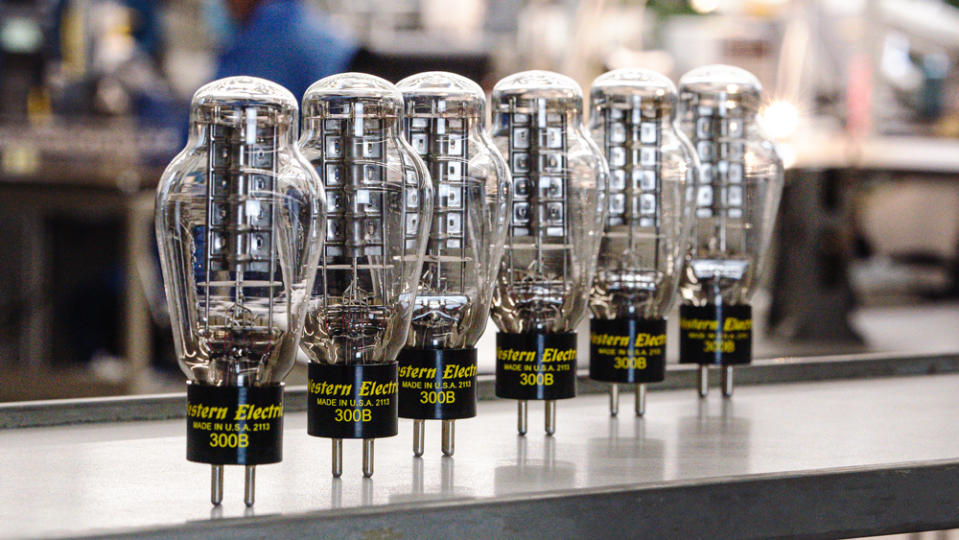
A 300B vacuum tube produces about 8 watts of power, the practical limit of the device when operated in a single-ended circuit. The 91E Integrated Amplifier employs Whitener’s patented Steered Current Source (SCS) technology that delivers greater power from the tube, with output rated at 20 watts per channel (WPC) into 8 ohms with 10 percent total harmonic distortion (THD). This extra margin allows the 91E to be used with a broader range of loudspeakers, not just super-high-efficiency horn-loaded designs.
One novel aspect of the amp is the ability to change the 91E’s default 8-ohm output transformer with a 4-ohm or 16-ohm option, matching impedance to the load presented by the user’s loudspeakers. These transformers, at $999 each, unplug for easy switching and come with an engraved top plate. On either side of the output transformer is one pre-installed ECC81 vacuum tube for the preamp circuit.
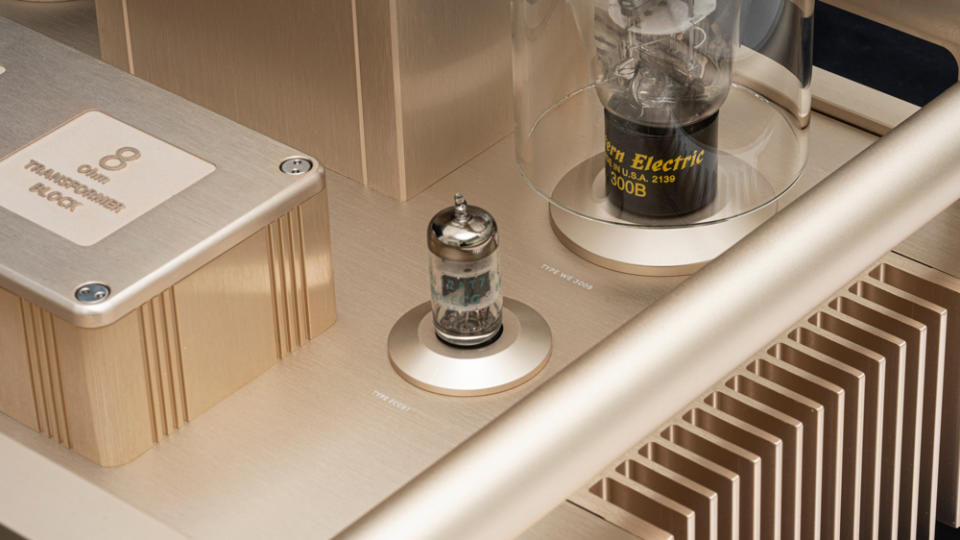
The front panel is divided into three vertical sections. At the left are selector buttons for sources, including Phono, CD, Tuner, Aux 1 and 2, and BT, the latter a streaming function that allows rational-thinking civilians (not audio nerds) the ability to enjoy the 91E without guilt. At the right is a massive and imminently satisfying volume knob, a standard quarter-inch headphone jack, and the Power/Standby button.
Absent a signal for 20 minutes, the 91E goes into Standby mode, requiring the warmup and bias sequence to be accomplished before music comes back home to roost. The center of the front panel is dominated by a vertical screen about the size of an iPhone, which upon startup, shows the original Western Electric logo, the Genius of Telegraphy, picturing the statue by Evelyn Beatrice Longman commissioned by AT&T in 1916 and more commonly called Golden Boy—a naked guy with wings, standing atop a globe, holding cables and lightning bolts.
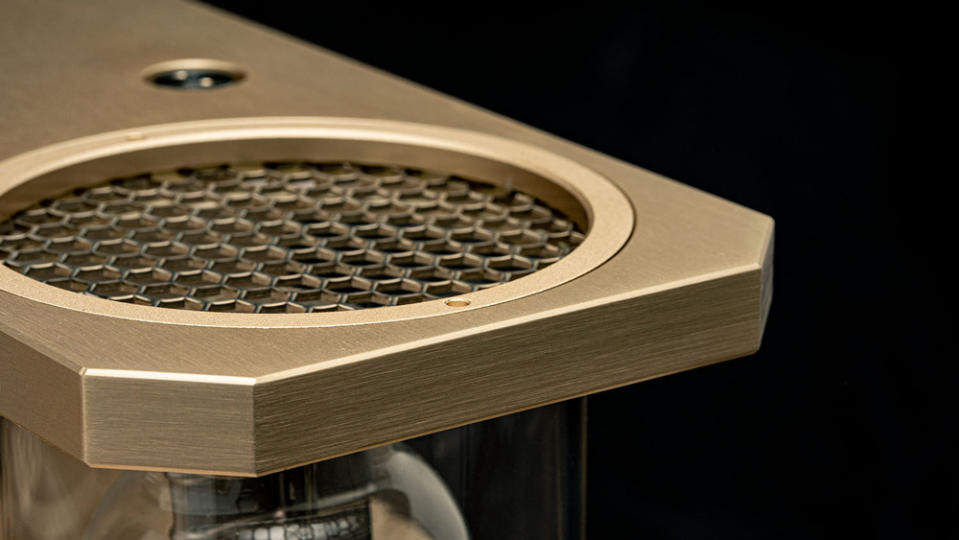
That historic image gives way to the countdown—Cape Canaveral style—of the automatic 30-second warm-up, followed by a 30-second bias check, upon the completion of which the 91E is ready to rock, roll, or simply waft its dulcet tones. Accolades go to the stout and well-made remote control. Housed in black aluminum and with real metal buttons, it has a great hand feel and shames the plastic garbage that accompanies many otherwise high-end components. Drop it at the peril of bare feet and the remote’s fine anodized casework.
An unlikely bedfellow for the high-end component, Bluetooth connectivity is a function that encourages other members of the household to embrace the user-friendly nature of the 91E, allowing it to be a constant companion in the musical journey. When things get serious, select a more substantial digital or analog source. Vinyl enthusiasts can rest comfortably knowing that the built-in phono stage of the 91E will accommodate a retinue of cartridges, and offers different loading choices for moving-magnet (MM) and moving-coil (MC) pickups. Because cartridges require an additional capacitive or resistive load to achieve ideal frequency response, Western Electric offers a variety of phono termination plugs to optimize MM and MC performance based on the cartridge manufacturer’s specification.
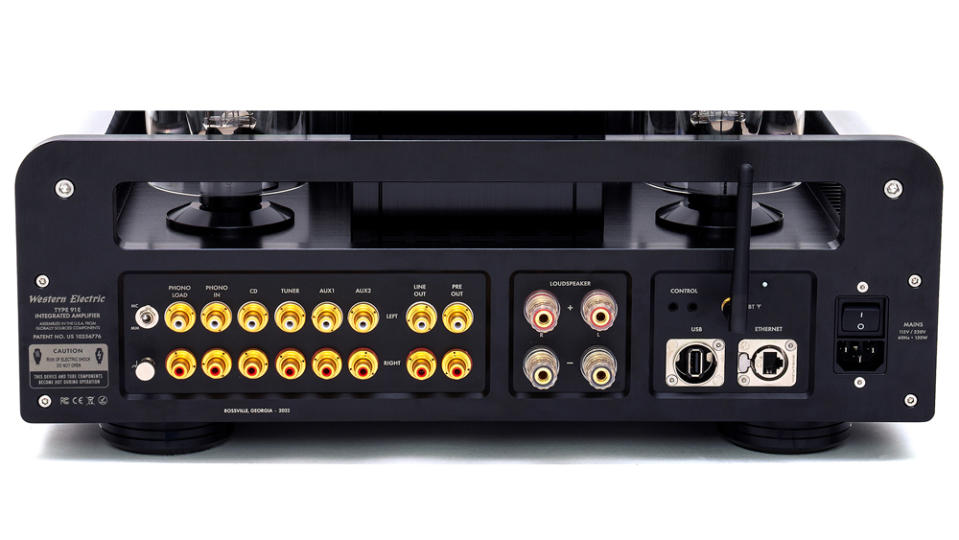
With about 20 WPC courtesy of Western Electric’s 300Bs, the 91E presents a rich, multi-layered audio experience that sounds as seductive as it is addictive. Extolling the sonic virtues of the 300B vacuum tube to someone unfamiliar with this amplification device is like explaining how a truffle is unlike any common mushroom. One taste suffices. Heretofore undiscovered textures, layers, and depth accompany the sound, as if a crystalline magnifying glass delivers added detail without any exaggerated enlargement of the object.
In the case of the 91E, it was sampled with a variety of likely and unlikely loudspeakers, using CD, streaming, and analog sources. In a less-than-palatial listening room (about 3,500 cubic feet) and at reasonable levels (around 85 dB), the 91E delivered plentiful and unstrained power into a pair of relatively inefficient Harbeth 40.2 monitors, a nominal 6-8-ohm load. These speakers, which are pretty dismissive of low-power tube amps, didn’t miss a beat, and in fact, produced more mellifluous and engaging sound—more warmth and micro-detail—than when driven by the 100-watt solid-state amp that regularly powers them.
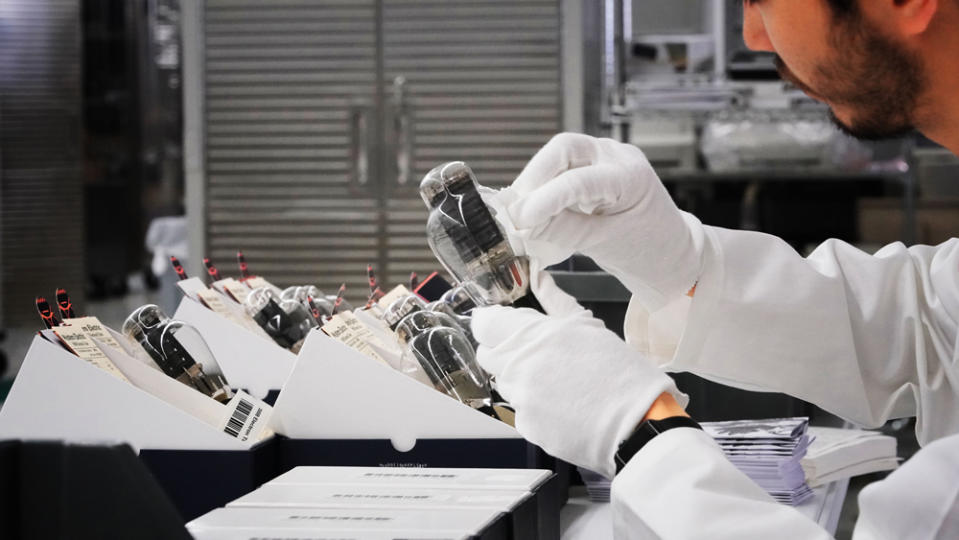
Remarkably, a speaker that should have little in common with a 300B-based design—the Quad 57 electrostatic—sang beautifully, and of course there was power to spare. A pair of fresh KLH Nines, upgraded by the electrostatic master David Jantzen, outdid themselves with the 91E, preferring the integrated to their usual VAC-reissue Marantz 8b, a venerable EL34-based push-pull design. Most recently, the 91E has been paired with our studio system using JBL L100 Classic loudspeakers. These 4-ohm, three-way designs aren’t terribly efficient, and in a large open space should tax most amplifiers without a surfeit of power, but here again, the 91E has abundant presence without stress or strain. An amplifier for all seasons, so to speak? Maybe.
Finally, this component’s exquisitely machined casework reminds us that audio gear can be jewelry, too. The lightly brushed aluminum is available in three anodized finishes: black and gold at $14,999, and nickel (warm silver) at $15,999. Your choice will depend on aesthetic preferences. We have been enjoying the black version, whose businesslike appearance suits the industrial setting of our studio.
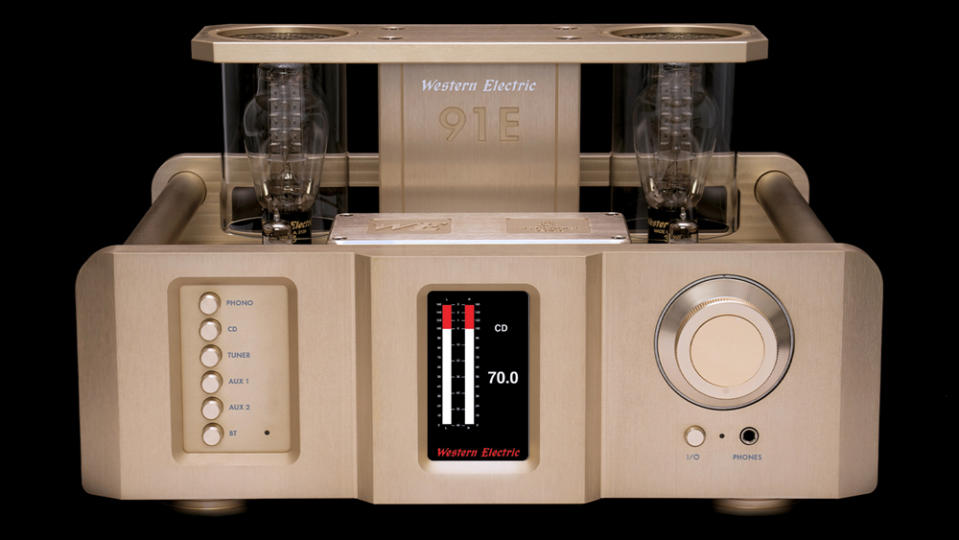
Is there a better single-chassis solution in high-end audio? Sure. For about $80,000, the new D’Agostino Momentum Integrated would do nicely, as would a few integrated amps from a handful of American, European, and Japanese manufacturers. But none of those will bring the magic of the Western Electric 300B vacuum tube to the party, and they all cost far more. After all, one taste of that intoxicating sonic elixir, and it’s hard to go back to anything else.
Click here for more photos of the Western Electric 91E Integrated Amplifier.
Sign up for Robb Report's Newsletter. For the latest news, follow us on Facebook, Twitter, and Instagram.
